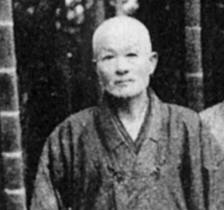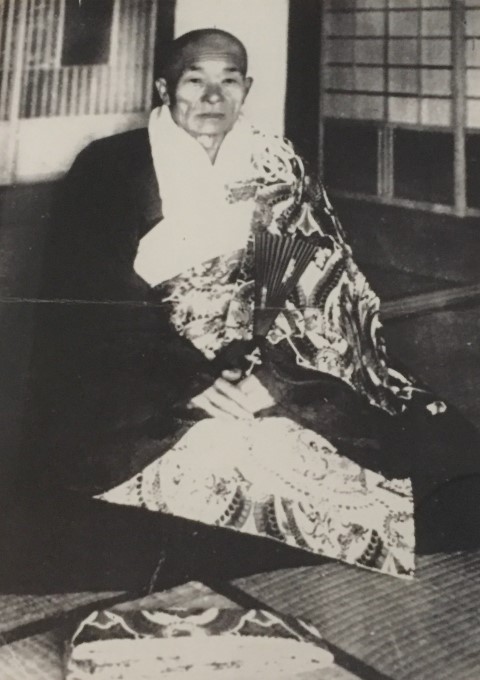Butsumon Sogaku Suzuki
 Shunryu Suzuki's father
Shunryu Suzuki's father
Here there's only what was in Crooked Cucumber. There's probably more in interviews, maybe some without using his name. But this material surely covers almost all of it that we know. - DC
Sogaku in Crooked Cucumber
Sogaku plays a big role in the first two chapters
Chapter 1, Childhood
Chapter 2, Master and Disciple
Chapter 3, Higher Education
FROM MID-NOVEMBER 1925 to mid-February 1926 Shunryu was in training at Kenko-in in Shizuoka City. So-on had sent him to be initiated as head monk under the guidance of Dojun Kato-roshi. Kenko-in offered the formal hundred-day practice period that is the heart of Zen training. One of the milestones of the training is the head monk ceremony. It wasn't like being head monk at one of the major training centers, where there would be many monks and teachers. At Kenko-in there were only Kato-roshi and a few novices, and Shunryu had to continue going to school during the day.
Many monks merely went through the motions of the ceremony for a few days at their home temple, an abbreviated formality to move a son closer to inheriting his father's temple. But Shunryu was head monk for the full one hundred days. Nine older priests came to the culminating ceremony, some arriving a few days early to participate in the practice and help build momentum for his rite of passage. Sogaku and So-on, with a few of his disciples, were among them.
…
ON AUGUST 21, 1926, in a private ceremony at Rinso-in, Shunryu Suzuki received shiho, dharma transmission, from So-on. He was twenty-two. In shiho the disciple receives his master's robe and his place in the lineage. It symbolizes the passing of Buddha's mind from generation to generation. Buddha meets buddha. Shunryu knew that it was just a formality and that he had a long way to go to understand the teaching of Buddha. So-on wanted Shunryu and his family to be responsible for Zoun-in, and the ceremony authorized the transfer.
Though Shunryu could now wear the brown robes instead of the monk's black, he would not yet change colors. That would be presumptuous. And though he was now his own man, he was still called Crooked Cucumber by So-on, who would continue to be in charge of his life for many years to come.
This was a big event for Sogaku as well. He retired as abbot of Shoganji, leaving it to a priest from Shizuoka, and finally moved with his wife, Yone, and daughter Aiko back to Zoun-in to be inkyo, retired master. So-on was still the abbot of Zoun-in in name, but Shunryu's family resided there and was in charge.
…
On January 22, 1929, at the age of twenty-four, Shunryu was installed by So-on as the twenty-eighth abbot of Zoun-in in the Mountain Seat Ceremony. The evening before there was a ceremony in which So-on stepped down, and the next day Shunryu ascended the mountain seat and assumed the title of jushoku, abbot. Sogaku would continue to run the temple, now for his son rather than for So-on. Through years of effort, Shunryu had regained for his father his lost temple. It had been possible only because that wasn't Shunryu's main goal.
…
This final ten'e ceremony gave Shunryu-san institutional creden-
tials. The whole community turned out for this big occasion, as did Miss Ransom, Dr. Yoshikawa's family, friends from school, and various priests and teachers he'd studied with. The next day he left by train for the two head temples of the Soto school, Eiheiji and Sojiji, for ceremonies in which he was honorary abbot of each for a day. This was the last of the ceremonies between So-on and Shunryu. His father would continue to be acting abbot while Shunryu finished his studies. That could go on indefinitely as far as Shunryu was concerned; he had other things in mind. Sogaku was old but still in good health, and his dharma brothers and fellow disciples of So-on, Kendo and Soko, would occasionally come from Rinso-in to help him.
…
Chapter 4, Great Root Monasteries
THE ABBOT of Eiheiji and archbishop of the Soto school was an old priest named Gempo Kitano-roshi. Shunryu regarded Kitano with great respect, for his sense of decorum and because he'd been abroad. Kitano had been the head of Soto Zen in Korea for a number of years and had been a founder of Zenshuji, the Zen temple in Los Angeles. One day in a dharma talk, Kitano spoke to the monks about smoking, which most of them did. He didn't tell them not to smoke, but described his own experience with tobacco. In his youth he had loved smoking. Once when he was out alone on takuhatsu, a begging trip, he was walking over the Hakone pass. At the top he stopped in the mist to sit on a rock. He lit a cigarette and found it immensely enjoyable to smoke and look down at the town below through the mist and the wisps of smoke. He particularly liked to smoke in damp weather and was so struck by the taste of the tobacco at that moment that he examined his desire directly and decided that it was a perfect moment for his last cigarette. And it was.
Though Kitano-zenji gave up smoking, he had the desire as long as he was alive, but he knew how to treat his desires. It is very foolish of you not to notice this point. I know it is difficult to quit smoking. I don't say you should give it up, but if you know this point, you will know how to treat yourself, even though it is difficult.
Kitano was older than Shunryu's father, but Sogaku said they'd been in school in Nagoya together and had trained together at one time. There was more than a hint of rivalry in Sogaku's tone when he spoke of the old man. Shunryu remembered how his father had complained about Kitano's becoming such an important priest while he, Sogaku, remained insignificant. Sogaku said it was because of Kitano's superior background and connections. In Kitano's presence, however, Shunryu knew there was much more to it than that.
…
The priest whom Shunryu had been chosen to serve was Ian Kishizawa-roshi, considered to be one of the greatest Soto masters of the day. So-on had arranged this connection. A disciple of the great root teacher Nishiari Bokusan, he had also studied under Nishiari's disciple, Oka Sotan, and had known So-on at Komazawa and at Shuzenji. He had also known Sogaku back in their younger days.
…
"Don't do that! You shouldn't do that!" Miss Ransom said to Shunryu's sister Aiko as she brought in bowls and platters of food stacked precariously upon one another. They wouldn't carry dishes that way in England or at Eiheiji. She disapproved of serving sake at the dinner table, and she chided Sogaku for smoking, saying that good Christian ministers neither smoked nor drank.
…
SOGAKU CONTINUED to play a major role at Zoun-in. Shunryu was often away helping So-on at Rinso-in and had taken over So-on's positions in two large, well-known temples, Kasuisai and Daito-in, where his responsibility was to give lectures to unsui and lead them in zazen.
Chapter 5, Temple Priest
In November of 1933, after a number of months of deteriorating health, Shunryu's father, Sogaku, died in his sleep. He had been a good husband and father. He was proud of his son, who had
made it possible for him to spend the last seven years of his long life back at Zoun-in. His body was laid out in the buddha hall. Shunryu and his mother greeted neighbors and danka as they arrived to pay their respects and offer incense. Tori and Aiko gave people cushions and took care of tea and food. At twenty-nine Shunryu became the head of the family and was now truly in charge of the temple.
IN LATE April 1934 So-on arrived at Eiheiji to assume the position of assistant director. He would be involved both with administration and with the training of monks. On his third day at Eiheiji, after lunch, he said, "I'm going to the toilet," then had a stroke and collapsed in the hall. From the Fukui hospital he was moved to Rinso-in for recovery, but his condition deteriorated. A week later, on May third, So-on passed away at the age of fifty-seven.
So-on had always walked with his head up and greeted people without looking at them, yet hundreds of laypeople and priests attended his funeral. His ashes were interred at both of the temples that he had run. Shunryu conducted the ashes ceremony at Zoun-in. So-on's new teardrop-shaped granite stone was placed next to Sogaku's in the abbots' line.
Chapter 9, An Opening
IT WAS May 18, 1959, Shunryu's fifty-fifth birthday and his forty-second year of priesthood. With Hoitsu at his side Shunryu offered incense to his father, Sogaku, and his master, So-on, at the ohaka behind Zoun-in--the temple where he and So-on had lived so intensely, so intimately.
Chapter 14, Taking Root
He visited his family's ashes sites behind the temples at both Rinso-in and Zoun-in. He cleaned up the grave and offered incense to his master, Gyokujun So-on, to his father, Butsumon Sogaku, to his mother, Yone, to his second wife, Chie, to So-on's lover, Yoshi, and with great sadness to his daughter Omi, who had hung herself two years before. Suzuki was not proud of himself as a family man. On this trip he had brought to these departed loved ones his greatest offering and only atonement--Western disciples and the hope for his dharma seeds to be spread and to cross-pollinate the Buddha's way between the two cultures he lived and breathed.
